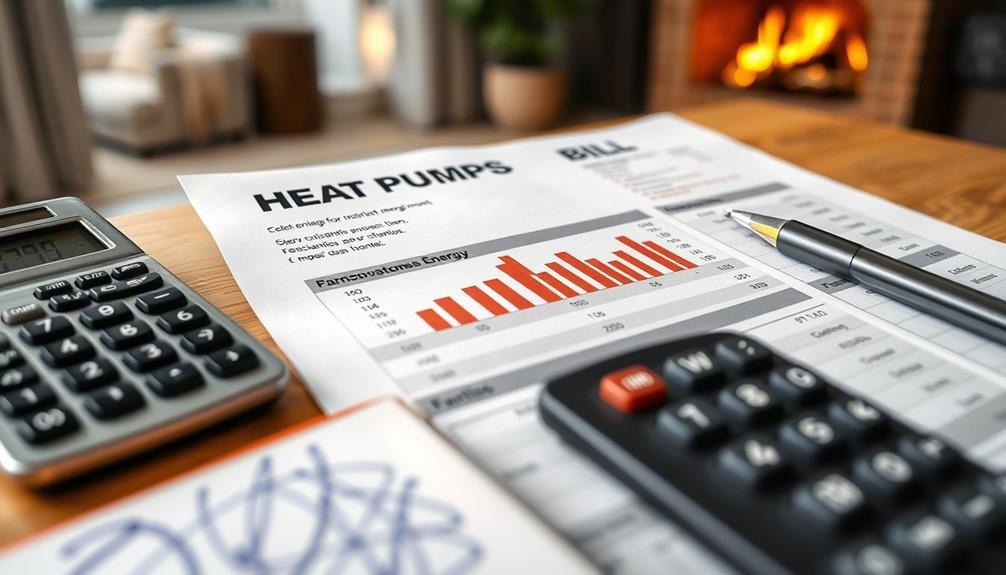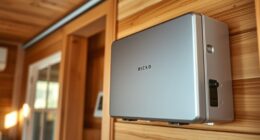To understand your heat pump's energy bill, start by checking the total energy consumption listed in kilowatt-hours (kWh). Break down the charges into electricity supply costs and delivery fees. Calculate the cost per kWh by dividing the total amount due by the total kWh consumed. Keep an eye on fluctuations in your bill; these may indicate inefficiencies. Pay attention to auxiliary heat usage during colder months, as it can greatly raise your costs. By monitoring these factors and implementing some simple strategies, you can better manage your energy expenditures. There's plenty more to discover about optimizing your heat pump's performance.
Key Takeaways
- Review your energy bill for total consumption in kWh, breakdown of supply and delivery charges, and any miscellaneous fees.
- Calculate the cost per kWh by dividing the total bill by the total kWh consumed for better understanding.
- Monitor auxiliary heat usage, as it can significantly increase costs during colder months when activated.
- Regular maintenance and efficiency ratings (EER, SEER, HSPF) of your heat pump can lower energy bills and improve performance.
- Analyze past usage trends year-to-year to identify improvements and potential savings in energy consumption.
Understanding Your Energy Bill
When you look closely at your energy bill, you'll find it packed with information that helps you understand your heat pump's electricity usage. The bill typically outlines your total energy consumption in kilowatt-hours (kWh), giving you insight into how much electricity your heating system uses. By monitoring this data, you can identify patterns in your energy consumption over time.
Regular maintenance is vital to guarantee that your heat pump operates efficiently, which can also be reflected in your energy costs. Additionally, understanding the efficiency ratings of your heat pump can provide insights into its performance relative to energy consumption.
You'll also see a breakdown of charges, including the cost of electricity supply and delivery fees. Understanding the cost per kWh is essential for evaluating your energy efficiency. You can calculate it by dividing your total bill by the total kWh consumed.
If your heat pump is new, you might notice higher electricity usage compared to your previous systems, especially if this is your first source of cooling.
Keep an eye out for significant changes in your bill. These fluctuations can indicate inefficiencies in your heating system, presenting opportunities for potential savings through better energy management.
Analyzing Heat Pump Usage
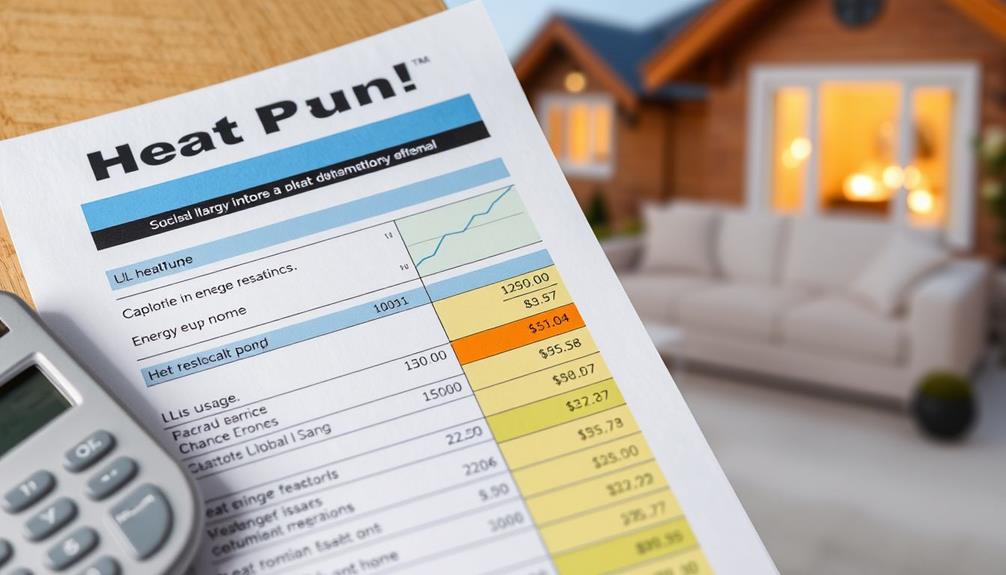
To truly understand your heat pump usage, you need to examine your energy consumption patterns closely.
It's crucial to evaluate the impact of indoor air quality on overall efficiency, as pollutants can hinder performance and increase energy costs.
Pay attention to how often auxiliary heat kicks in and how seasonal changes affect efficiency. These factors can drastically impact your electricity bill, especially during extreme temperatures.
Regular maintenance of your heat pump can also contribute to better performance and lower energy bills, similar to how ozone air purifiers help enhance air quality.
Energy Consumption Patterns
Understanding how your heat pump's energy consumption patterns fluctuate can help you manage your energy bills effectively. Heat pumps typically consume around 3000 watts during regular operation, similar to the energy used by 30 traditional 100-watt light bulbs.
However, when you engage auxiliary heat, your energy usage can skyrocket, adding an additional 15,000 watts to your total. Regular monitoring of your energy consumption can also support gout management insights as maintaining a balanced lifestyle is vital for overall health.
Monitoring energy consumption is essential, especially during colder months when usage tends to spike. You might notice that your electric bills can double or even triple due to this increased demand.
For instance, a weekly cost of $28 during normal operation might jump to $195 with auxiliary heat engaged.
Understanding this balance between standard heat pump energy usage and the activation of auxiliary heat is important for keeping your costs in check. By recognizing when your system is working harder, you can take proactive measures to mitigate expenses.
Auxiliary Heat Impact
Have you ever wondered how auxiliary heat impacts your heat pump's efficiency and your energy bills? When your thermostat is raised more than 2°F above its current setting, the auxiliary heat mode kicks in, leading to a significant increase in energy consumption. This mode can consume an additional 15,000 watts, causing your electricity bill to skyrocket compared to normal operation.
Understanding the cruise costs and planning can also help you budget effectively for unexpected expenses.
Typically, your heat pump operates at around 3,000 watts, which is similar to the energy used by 30 traditional 100-watt light bulbs. However, when auxiliary heat is engaged, that number dramatically rises. You might see your weekly heating costs leap from about $28 during standard operation to around $195 when auxiliary heat is in use.
In extremely cold weather, the demand for heating can double or even triple, further increasing your heating costs as the heat pump runs longer hours.
Understanding how auxiliary heat affects your energy consumption is crucial for managing your electricity bill effectively. By being mindful of when this mode activates, you can make informed decisions to keep your heating costs under control.
Seasonal Efficiency Variations
When you consider how auxiliary heat spikes your energy bill, it's also important to look at seasonal efficiency variations in your heat pump's performance.
Heat pumps have efficiency ratings like EER, SEER, and HSPF, which help gauge energy usage during different seasons. Ideally, you should aim for minimum ratings of 12, 15, and 8.2, respectively, to guarantee peak performance.
Additionally, understanding the benefits of diversifying your energy sources can lead to more informed decisions regarding your heating options, especially during peak seasons benefits of diversifying investments.
As temperatures drop below 30°F, you'll notice that your heat pump's efficiency declines, leading to increased electricity consumption.
This is particularly evident when auxiliary heat kicks in automatically to meet indoor temperature demands, adding an extra 15,000 watts to your energy usage.
When conditions become extremely cold, operating costs can spike, with weekly bills potentially rising from $28 to $195 due to supplemental heat.
To manage your expenses effectively, monitor seasonal efficiency variations closely.
This awareness allows you to identify trends in your heat pump's performance, empowering you to make informed adjustments to settings.
Energy Efficiency Ratings
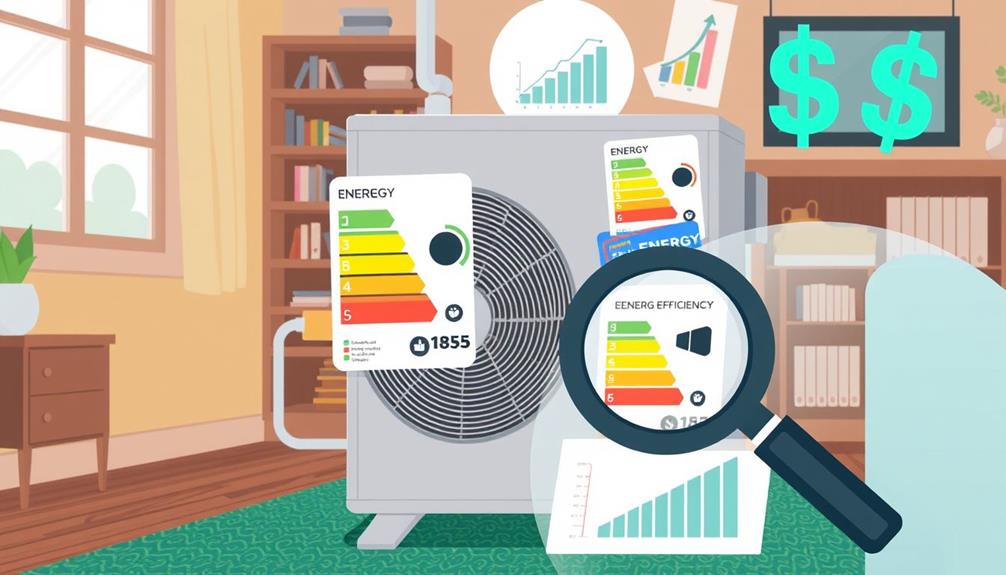
When you're looking at your heat pump's energy efficiency, understanding EER and SEER is key to maximizing your savings.
Utilizing energy-efficient systems, such as Garage Door Openers, can complement your heating strategy by reducing overall energy consumption.
EER measures cooling efficiency, while SEER provides insight into overall performance throughout the season.
Don't forget about HSPF, which helps you gauge heating efficiency—higher ratings in all these areas can mean lower energy bills for you.
Understanding EER and SEER
Understanding the Energy Efficiency Ratio (EER) and Seasonal Energy Efficiency Ratio (SEER) is vital for making informed decisions about your heat pump. The EER measures your heat pump's cooling output during a cooling season. It's calculated by dividing the cooling output by the electrical input, with a recommended EER rating of at least 12 for ideal energy efficiency.
In contrast, the SEER reflects efficiency over an entire cooling season, accounting for seasonal temperature variations. A minimum SEER rating of 15 is typically recommended to guarantee better performance.
Additionally, just as regular maintenance can extend the lifespan of a toilet, proper upkeep of your heat pump can enhance its efficiency and longevity, ultimately saving you money on your bills and reducing your environmental impact. Higher EER and SEER ratings indicate superior energy efficiency, which can lead to lower energy bills.
When you choose a heat pump with better ratings, you're not just saving money; you're also reducing your environmental impact. It's crucial to mention that EER is measured under specific conditions—95°F outdoor temperature and 80°F indoor temperature at 50% relative humidity—whereas SEER considers a range of temperatures throughout the season.
Importance of HSPF
The Heating Seasonal Performance Factor (HSPF) is just as important as the EER and SEER ratings when it comes to evaluating your heat pump's efficiency. HSPF measures the total heating output during the heating season compared to the total electricity consumed. A higher HSPF rating indicates better efficiency, which can greatly impact your energy costs.
For energy-efficient heat pumps, aim for a minimum HSPF rating of 8.2. Understanding the nuances of energy generation, such as geothermal energy generation, can also provide insights into choosing a heat pump that aligns with sustainable energy practices.
When you choose a heat pump with a higher HSPF, you're not only ensuring effective heating performance but also reducing your electricity bills over time. This is especially vital if you live in a colder climate, where heat pumps can struggle without sufficient efficiency ratings.
When comparing models, look for those with HSPF values notably above the minimum. This can lead to substantial long-term savings and increased comfort in your home.
Understanding HSPF will guide your purchasing decisions, helping you select units that require less reliance on auxiliary heating sources, ultimately lowering your overall energy costs. Remember, investing in a heat pump with a high HSPF is a smart choice for both your wallet and your comfort.
Monthly Cost Breakdown
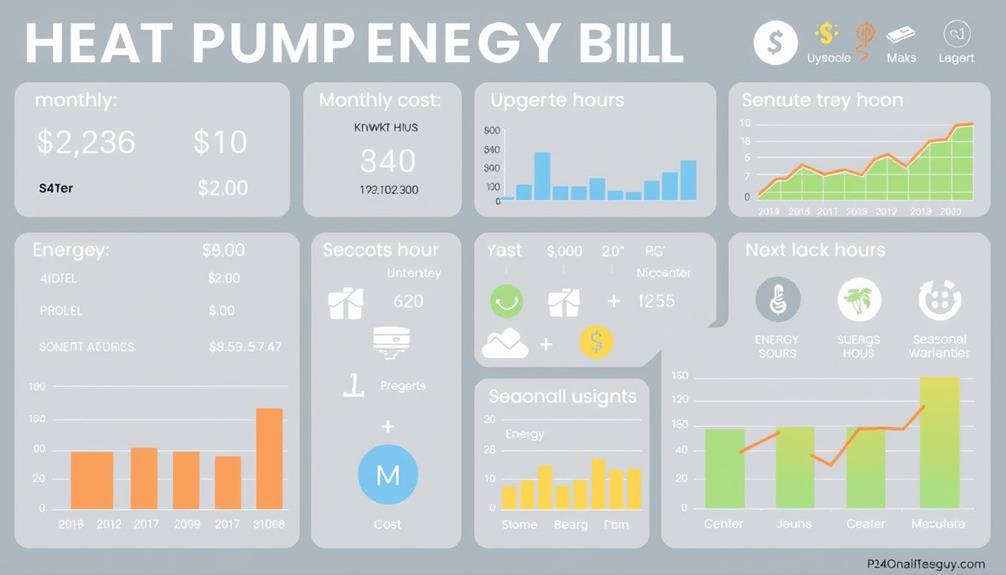
Although your heat pump's energy bill can seem complicated, breaking down the monthly costs reveals essential details about your energy usage. Understanding these costs can empower you to manage your consumption more effectively. Here are some key components to look for:
Additionally, being aware of your heat pump's maintenance requirements can help you optimize its efficiency and reduce energy costs.
- Supply Charges: Costs for electricity generation.
- Transmission/Distribution Charges: Fees for grid maintenance.
- Miscellaneous Charges: Taxes and additional fees.
- Usage Trends: Monthly and average daily consumption data.
To calculate your total bill cost, divide the total amount due by the total kilowatt-hours (kWh) consumed during the billing cycle. This helps you understand your cost per kWh, giving you insight into your electricity usage patterns.
Keep an eye on any fluctuations in your heat pump's energy usage, especially if you use auxiliary heat during colder months, as this can add a significant amount, potentially up to 15,000 watts.
Understanding these charges not only helps assess your heat pump's efficiency but also highlights areas where you could potentially reduce your energy costs. By staying informed, you can make smarter decisions about your energy consumption.
Strategies for Reducing Bills
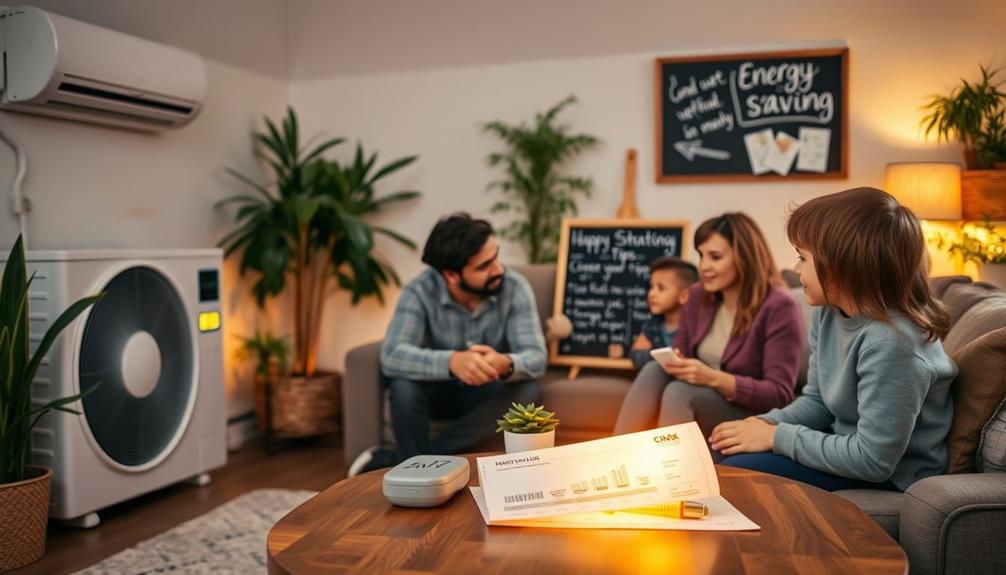
Numerous strategies can help you reduce your heat pump's energy bills and improve efficiency. Start by scheduling regular maintenance for your efficient heat pump; this can enhance its performance and potentially cut energy consumption by up to 10%.
Additionally, adopting a holistic lifestyle approach, such as focusing on mindful eating, can contribute to overall well-being and energy efficiency in your home. Another effective tactic is to install a programmable thermostat. By optimizing heating and cooling based on your daily routine, you could lower energy usage by 20-30%.
Sealing cracks and gaps around windows and doors is also essential. This improves insulation, ensuring your HVAC system doesn't work harder than necessary, which can lead to significant savings.
Additionally, set your heat pump to a consistent, comfortable temperature instead of frequently adjusting it. This simple practice helps maintain efficiency and lowers your electric bills.
Comparing Past Usage Trends
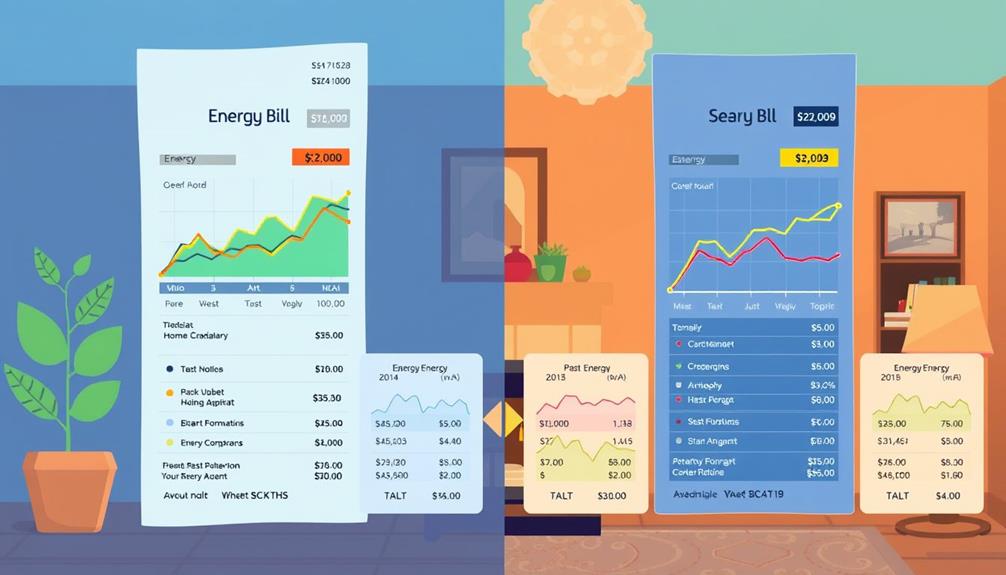
Analyzing your past energy bills can reveal valuable insights into your heat pump's performance and usage patterns. By reviewing these documents, you can identify trends that may help you manage your energy consumption more effectively.
Consider the following points:
- Seasonal peaks in energy usage during colder months
- Monthly and average daily electricity usage comparisons
- Year-to-year analysis of energy efficiency improvements
- Impact of tiered billing structures on overall costs
When you look at your bills, pay attention to seasonal usage patterns. You'll likely notice your heat pump working harder during colder months, leading to increased electric usage.
Comparing your monthly and daily average electricity consumption can also shed light on how changes in temperature or settings affect your energy bills.
Moreover, analyzing year-to-year usage helps you assess the effectiveness of any energy efficiency improvements you've made.
By utilizing tiered billing structures, you can understand how different usage levels impact costs, encouraging you to adopt more mindful energy practices.
Frequently Asked Questions
How Much Will a Heat Pump Increase the Electric Bill?
Installing a heat pump can greatly increase your electric bill, especially if you didn't have prior cooling systems. On colder days, costs may double or even triple, depending on your home's heating needs and usage patterns.
How Do You Calculate the Energy of a Heat Pump?
Calculating your heat pump's energy is as simple as a math exam you never studied for. Just track your kWh usage over a billing period, multiply by your electricity rate, and voilà—energy expenses revealed!
Do Heat Pumps Use a Lot of Electricity?
Yes, heat pumps can use a lot of electricity, especially in colder weather. When auxiliary heating kicks in, their energy consumption surges considerably, which can lead to noticeably higher electricity bills if not managed properly.
What Is a Good Energy Rating for a Heat Pump?
A good energy rating for a heat pump is essential. Aim for an EER of at least 12, a SEER of 15 or higher, and an HSPF of 8.2 to guarantee peak performance and efficiency.
Conclusion
As you immerse yourself in your energy bill, remember that understanding it can transform your relationship with your heat pump. Coincidentally, the more you learn about your usage and costs, the better equipped you'll be to make informed decisions. By adopting energy-efficient strategies and tracking your trends, you could find yourself saving more than you ever expected. So, take control and watch your bills shrink while enjoying the comfort your heat pump provides—it's a win-win!
